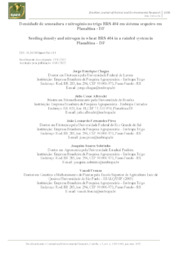Densidade de semeadura e nitrogênio no trigo BRS 404 em sistema sequeiro em Planaltina-DF.
Densidade de semeadura e nitrogênio no trigo BRS 404 em sistema sequeiro em Planaltina-DF.
Author(s): CHAGAS, J. H.; ALBRECHT, J. C.; PIRES, J. L. F.; SOARES SOBRINHO, J.; FRONZA, V.
Summary: Resumo: O cultivo do trigo sequeiro na região do Cerrado do Brasil Central tem crescido nos últimos anos e vem contribuindo para diversificar os sistemas produtivos na região. Objetivou-se avaliar diferentes densidades de semeadura e a aplicação em cobertura de diferentes doses de nitrogênio na cultivar de trigo BRS 404 cultivada no sistema de sequeiro, sem irrigação, no período da safrinha. O delineamento experimental utilizado foi de blocos ao acaso, com parcelas subdivididas e quatro repetições. A parcela foi constituída por quatro densidades de semeadura (150, 250, 350 e 450 sementes m-2) e na subparcela cinco doses de nitrogênio (0, 30, 60, 90 e 120 kg ha-1) aplicadas em cobertura durante a fase do perfilhamento. Após a emergência foi realizada a contagem de plantas e determinando o estande inicial. Antes da colheita foi realizada a contagem de espigas e após a colheita também foram determinados o rendimento de grãos, o peso hectolítrico e o peso de mil grãos. O rendimento de grãos máximo da BRS 404 foi obtido com 196 sementes m-2e 37 kg de Nha-1. O peso hectolítrico e o peso de mil grãos diminuíram com o aumento da densidade e do nitrogênio em cobertura. Abstract: The cultivation of non-irrigated wheat in the Cerrado region of Central Brazil has grown in recent years and has contributed to the diversification of production systems in the region. The objective of this study was to evaluate different sowing densities and the application in top dressing of different nitrogen doses on wheat cultivar BRS 404, planted as a second crop in a rainfed system. The experimental design used was randomized blocks, with split plots and four replications. The plot consisted of four sowing densities (150, 250, 350 and 450 seeds m-2) and in the subplot five nitrogen doses (0, 30, 60, 90 and 120 kg ha-1) in top dressing applied during the tillering phase. After emergence, plants were counted and the initial stand was determined. Before harvesting, ear counts were performed and after harvesting, grain yield, hectoliter weight and thousand grain weight were also determined. The maximum grain yield of BRS 404 was obtained with 196 seeds m-2 and 37 kg of N ha-1. Hectoliter and thousand grain weight decreased with the increase in plant density and in nitrogen concentration applied in top dressing.
Publication year: 2022
Types of publication: Journal article
Unit: Embrapa Wheat
Related content
Observation
Some of Embrapa's publications are published as ePub files. To read them, use or download one of the following free software options to your computer or mobile device. Android: Google Play Books; IOS: iBooks; Windows and Linux: Calibre.
Access other publications
Access the Agricultural Research Database (BDPA) to consult Embrapa's full library collection and records.
Visit Embrapa Bookstore to purchase books and other publications sold by Embrapa.

